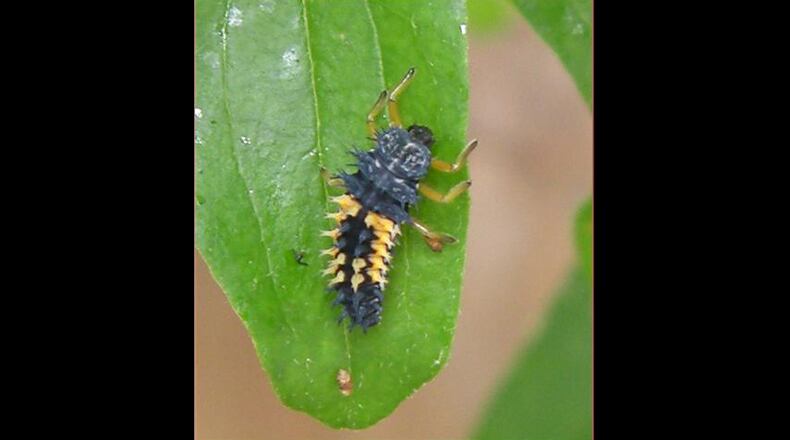Q: I’m a new gardener and my pea plant stems are absolutely covered with small, dark gray creatures. Louise Lubben, Fulton County
A: In May/June each year, aphid populations can explode on susceptible plants like peas, onions and peppers. They weaken plants by sucking the sap from stems and leaves. Look closely and you might spot ants feeding on the undigested honeydew from aphids. You might also see orange and black “alligators” (larval ladybugs) feeding on unlucky aphids. Since we don’t want to hurt beneficial insects, the easiest solution for aphids is to blast them off plants with a strong stream of water. They have difficulty crawling back up the plant, and hungry ground beetles will have an excellent meal.
Q: I just had a beautiful stone raised bed built across the front of my house. It is 17 feet long, 12 feet wide and 3 feet high. I have been filling it with soil: first from my yard but then with bags of the inexpensive topsoil from a local home center. I hope to plant a Japanese maple in the center. When getting another load of bags, the guy helping load my car said this was absolutely the wrong soil to be using. I thought topsoil was supposed to be good dirt. I am very distressed after so much work. I do not want to stunt the growth of the tree, nor do I want to remove all the soil that I have added. Cindy Dobbins, email
A: I know you have made a big investment in labor and soil material, but I think the landscape person was right. Inexpensive bagged topsoil is rarely any good. In my observation, it is usually composed of poorly composted wood chips, silt and sand. This mix will not support good plant growth. In addition, having different layers of materials in your raised bed will make for a very poor rooting environment. The expense of your nice Japanese maple could be wasted.
I can’t think of a solution other than removing the material in the bed and replacing it with good-quality topsoil from a landscape supply company. Examine the soil before it is delivered to be sure it’s a homogeneous brown, sandy loam. Another soil option is to have big supersacks delivered to your site. Erthfood (erthproducts.com) and Soil3 (soil3.com) are two local producers. A third option is to use good-quality but more expensive bagged products from the local home center. I have the good results of my experience with these products at bit.ly/GAbaggedsoil.
Walter’s email address is georgiagardener@yahoo.com. Listen to his comments at 6:35 a.m. on “Green and Growing with Ashley Frasca” Saturday mornings on 95.5 WSB. Visit his website, www.walterreeves.com, or join his Facebook Page at bit.ly/georgiagardener, for his latest tips.
About the Author
The Latest
Featured
